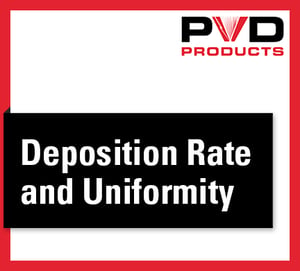 What are the key parameters of interest to anyone selecting a tool for thin film deposition? They are, of course, the film properties themselves. Concerning the process of growing the film, the most fundamental are the deposition rate and film thickness uniformity. The rate is important to reach proper film thickness in single or multi-layers, and to achieve stoichiometry in co-deposited films. The rate also correlates to how economically viable the system will be via the throughput: how long it will take to create the layer needed to serve a particular purpose. The uniformity determines how much of the film area will hold to these metrics over the entire area of the substrate, to within a desired tolerance.
What are the key parameters of interest to anyone selecting a tool for thin film deposition? They are, of course, the film properties themselves. Concerning the process of growing the film, the most fundamental are the deposition rate and film thickness uniformity. The rate is important to reach proper film thickness in single or multi-layers, and to achieve stoichiometry in co-deposited films. The rate also correlates to how economically viable the system will be via the throughput: how long it will take to create the layer needed to serve a particular purpose. The uniformity determines how much of the film area will hold to these metrics over the entire area of the substrate, to within a desired tolerance.
To properly specify and design a deposition tool, these two quantities need to be understood and predicted. Below we explain how to navigate the prediction process.
Predicting a Complex Process
The deposited film thickness profile is a combination of several factors, including:
1. Geometry of the chamber
The geometry includes the location of the target relative to the substrate – the position in three dimensions and the angle of the target and substrate surfaces.
2. Substrate motion
The substrate is typically rotating on one or two axes (planetary motion). The planetary axis can be both offset and tilted relative to the first rotation axis, and the absolute and relative angular velocities of the motion axes can be varied. Motion can also be linear, such as in large rectangular substrates, multiple small items laid out in a large array, and reel-to-reel applications, where the substrate material to be coated may make several passes through the deposition zone.
3. Substrate size and form
Substrate size can vary from millimeter to meter dimensions and may be flat, convex, or concave. Variable facing angles to the deposition source and shadowing can become an issue if the part is highly three-dimensional.
4. Target emission properties
Sputtering and evaporation sources are not point emitters of material but rather extended surfaces. The emission varies across the surface and has an angular emission profile. The rate and pattern of material ejection from the target depends on the material properties and power applied. For example, in Pulsed Laser Deposition (PLD), the plume originates at a point-like ablation spot and is highly forward-directed. This spot can in turn be scanned over the target surface with varying velocity.
5. Masking
Finally, there are geometries for which it is difficult to obtain the required uniformity. Shadow masks can provide a way to trim the emission profile of the target, improving uniformity. The masking process is difficult to predict and has traditionally required experimental trial-and-error to accomplish a desired uniformity.
With all of these factors in mind, a well-designed custom deposition tool must come together based on predictive knowledge of its behavior. For maximum cost efficiency, the chamber size and the process throughput should be optimized for each application. An over-sized chamber is a waste of space and money, while an insufficiently specified system will yield unsatisfactory results.
Not sure where to start with your deposition system planning? Download our eBook for an easy guide to help you through the process, Choosing a Thin Film System:
PVD Products uses both in-house and commercial software to model the deposition system behavior. This capacity enables us to quickly optimize designs and eliminates wasteful guesswork. In the next blog, we will discuss design aided by the modeling and optimization process.




Leave a Comment